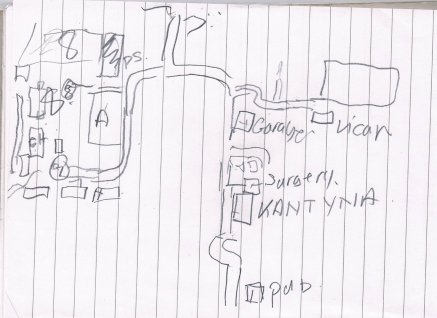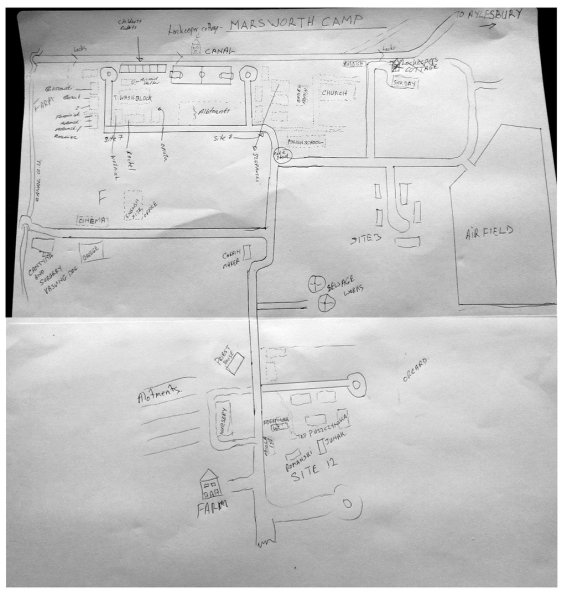Lutek Foremniak
Lutek visited Marsworth with his daughter Eva from Coventry in 2019. This is his story and memories of childhood in Marsworth.
Lutek’s parents came from Michalin, now in Belarus, near Brest. The whole population of the village was taken to Siberia by the Russians. They travelled from Michalin to Archangelsk, USSR, then to Persia, Lebanon, then to Liverpool, arriving on 15th June 1948. Lutek came to England at the age of two. His family first went to Newton Abbot in Devon before moving to Marsworth.
They first lived in a Nissen hut on site 12. The huts were cold and housed up to three families with rooms separated by blankets or curtaining of some sort. They then moved to Site 7 to a rectangular type of hut; these were known as ‘baraky’ (barracks) and were made of wood, plasterboard and felt. These usually housed three families, with plasterboard partitions.
Site 7
There was a big coke and coal store on the right near the entrance to site 8. The concrete base is still visible.
None of the accommodation had toilets - they were in separate blocks, which were also separate from the washrooms.
There was a big air raid shelter on site 7, which was used as a cold store. In Polish they called it ‘schron’, i.e. shelter.
There were vegetable plots near the canal. Each family would have their own area. There were also allotments on Sites 8, 7 and 12. Each group of huts had their own. Lutek’s father used to grow tobacco and Lutek used to cut the tobacco for his father in the shed.
They also kept chickens and rabbits and geese in a chicken and rabbit run, fenced off into family sections, near the boundary near Lock 4. Lutek used to collect dandelion leaves to feed the rabbits.
Both sites 7 and 8 had a spur road off from the camp boundary road, each with a roundabout at the end.
The football pitch was between sites 7 and 8.
Adamski or Adamczyk or Adamiec lived in the same barak as Foremniak. There was an old man and his wife and a son and his wife.
There were two Buczak brothers, Edward and Ryszard, who was the younger of the two. Edward Buczak was a brilliant accordion player. He taught Lutek to play.
There was a sick bay NW of Site 8, using the buildings which had been an isolation hospital during the war. This was behind the camp church, near a stream and a big rubbish dump.
The church was on Site 8 in a large Nissen hut. When there was a funeral, they had the service in the church and then the cortege made its way to the village churchyard for the burial.
There were also some brick built administration buildings. A site official lived opposite the chapel - some sort of administrator for the running of the camp. He was Polish and his accommodation was better than most of the others. He was there to sort out any problems you might have. He spoke better English than most of the Poles.
The Polish Saturday school was also on Site 8. Lutek used to play truant from the Polish Saturday school! Lutek wasn’t in the scouts.
There was a nursery on site 12 in a large Nissen hut. The priest lived in the adjacent hut, on the right at the top of the hill as you approached site 12.
Coming down from site 12 towards the village, there was a sharp S bend where there was a coffin maker in a big house.
Lutek began at Marsworth School in 1950 at the age of 5. He was then living at Site 12 and used to walk to school across the fields. For a while he was sent to private Polish boarding schools in Hereford and Henley, but his parents could not afford to keep that up (his father was of retirement age and his mother worked as a seamstress) so he returned to Marsworth School between the ages of 9 and 11. The headmistress of Marsworth School was called Mrs Pennycock. She had a son called Nigel and they lived in the house next to the school. Richard Napier, a friend of Lutek’s, lived across the road. There was also a pair of twins.
To get to Marsworth School from Site 7 the children had to walk across the lock at the canal and make their way along the canal to the road because the nearby farmer did not like them cutting through his farm.
After his 11+ he went to a school in Aston Clinton for a year before going to The Grange in Aylesbury. He used to walk to the T junction of Vicarage Road / Lower Icknield Way to get the school bus to go to The Grange.
The kantyna was just over the (Red Lion) bridge where you could go and play billiards. It also had their first communal television where the children watched “Bill & Ben”. The doctor’s surgery was behind the kantyna. There was also a big water tower that they used to climb. Moving past the kantyna towards Lower End garage, there were several warehouses (magazyny). There was a road near the warehouses which they were not supposed to use, but they did because it was a short cut to site 12. Near the magazyny there was a pond where you could catch newts.



